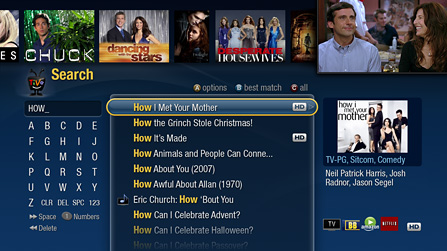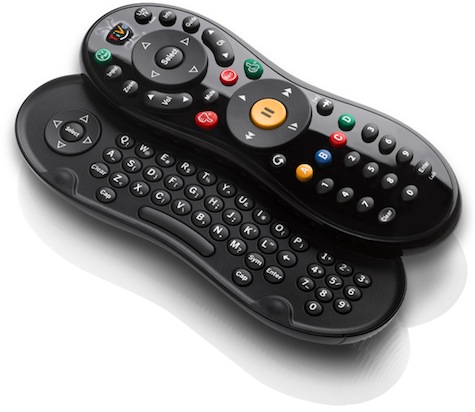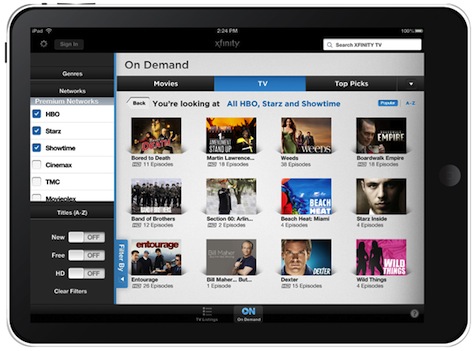Have you ever felt it’s harder to find something to watch on television now than it was when there were fewer choices? This can partly be attributed to the dilution of content quality, but a greater problem is that operating a television and discovering content is much more complicated than it used to be.
Television, Evolved
For fifty years, watching television was as simple as turning on the set and flipping through limited, regularly scheduled programs. Technological improvements have made this experience easier by eliminating the need to adjust your antenna, introducing remote controls, and adding geographically and topically diverse channels, among other advances.
The introduction of the VCR likely represented the first technological advance for television that also introduced significant user confusion. The advantages of recording a show and watching it at your own convenience are obvious, but the “TV/VCR” button that switched back and forth between scheduled and recorded programming baffled some users to the point of abandoning VCR technology altogether.
More recently, TiVo and other digital video recorders (DVRs) attempted to integrate the television viewing and recording experience more tightly. They introduced many now-common features such as instant replay, pausing of live TV, and time shifting. If you own a DVR, you no longer need to know or care when your favorite shows are on; your DVR will record them for you automatically, and you can watch them at your convenience. In some cases, your DVR can even record shows for you that it algorithmically guesses you might also like, based on your viewing habits. And—perhaps most importantly—you can operate it all from one remote control.
But what if you add a DVD player, a surround-sound audio receiver, and a game console? How many remotes are on your coffee table now? Now add Netflix, Hulu, iTunes, Vudu, YouTube, podcasts, and cable providers’ on-demand services.
Consumers have many more video options available to them now. Consumer electronics manufacturers are scrambling to bundle as many services as possible into their television and set-top boxes, and the services themselves are all fighting for mindshare, competing to paint their logos on your screen, in menus, and even on your remote. Televisions are no longer just portals to free, ad-supported programming; they’re now digital media services shopping centers.
New Patterns
Just as VCRs introduced new usage patterns and experiences for television viewers, so do all of these new devices and services. But they add more than just a few new features that require an extra button or two; these new types of content depend on new methods of discovery and consumption. The traditional, temporal program guide still makes sense for scheduled content, but on-demand content doesn’t fit into that model. How do you integrate paid or on-demand video, amateur and independent content, and scheduled programming into one seamless experience? Is it even possible?
This problem is easier to solve on a computer, and many consumers are watching video content on laptops or mobile devices. But television as a device is still alive and well in most consumers’ homes; it’s just getting more capable, and more complicated.
As electronics manufacturers struggle with content integration challenges, one thing seems certain: it’s going to get worse before it gets better. Service providers and manufacturers alike are trying to devise their own proprietary, branded solutions. This means a different user experience for every service on practically every device. And with everyone rushing new products out to customers, the living room is becoming cluttered with keyboards, controllers, and touch pads.
Some Good First Steps
With all of these products on the market, no one has yet designed a good, simplified television experience that seamlessly integrates all available content sources. But there are some interesting products that can change the home viewing experience for the better. The ideal solution will likely require a combination of hardware and software innovations. These are some examples of the better ones.
Aggregated Search
Most of today’s consumer video products “integrate” content services by introducing independently designed and developed widgets or apps. Apps are the big new thing; everybody likes apps, right? Content and service providers typically like apps because they can control the experience and throw their brand all over the screen. And users often like apps because they offer modular access to the content that interests them. But apps also create a fragmented viewing experience by locking media into content silos. Each app is designed to look and behave differently. And how do users know which app contains which content?
One popular DVR, TiVo, attempts to address this problem with its aggregated search feature. Start typing the name of a program or performer, and TiVo Search finds content across a handful of sources, including multiple online sources and traditional scheduled programming. If the content you’re seeking is on now, you can watch it immediately or record it. If the content is available through a streaming partner, you can purchase it, rent it, or watch it for free, depending on the service. The idea is that one search finds all content, regardless of its source. TiVo’s service is far from perfect, as it doesn’t yet include all of TiVo’s partner service providers, but it’s a good step in the right direction.

The Hybrid Remote/Keyboard
Search requires some form of text entry, so the simple direction controls on most remotes don’t cut it anymore for robust content discovery and selection. Some device manufacturers support multi-tap or T9 text entry on a remote control’s number keys. This is a clever workaround, but it’s cumbersome and time-consuming to use. TiVo may have designed the best overall solution, recently integrating a slide-out keyboard into its award-winning peanut-shaped remote control. Other manufacturers are also experimenting with integrating a keyboard into the remote. This gives users the flexibility of a keyboard when it’s needed but keeps it hidden when it’s not. Who wants a keyboard sitting out on the coffee table all the time? It’s likely that consumers will see more remote controls with integrated keyboard components as content search and discovery becomes an increasingly important part of the television viewing experience.

Tablet as a TV Accessory
If content discovery is difficult with a television remote, why not take it off the TV and move it to something that more and more people have with them while watching TV—a tablet device? Comcast, TiVo, and other set-top-box providers have released tablet apps that let users explore content in ways never possible on the larger screen. Quickly scanning through categories, searching for keywords, and filtering by interests with swipes and taps gives television users unprecedented access to previously undiscovered content, all without disturbing the on-screen viewing experience.

While most of these solutions operate just one device (a set-top box), one product, Peel, tries to solve that problem by rethinking the approach to answering the question, “What’s on now?” It lets users control multiple devices from one interface. Peel acts as a universal remote that controls your entertainment center devices based on interactions with your touch device. Unfortunately, Peel doesn’t integrate content from popular online content providers, and it doesn’t yet integrate your own recorded shows or other DVR functions. But with a mission derived from the question, “Why is TV so hard?” they seem to be on the right track.

These interactive accessory solutions introduce a new approach to content discovery by abstracting traditional program listings into a rich, visual experience. You’re browsing colorful show tiles and movie posters in your hand rather than wading through screen after screen of channel numbers and text, and you’re doing it without interrupting what you or the family are already watching.
Is This As Good As It Gets?
Two of television’s biggest, new usability problems are that finding and accessing content is difficult, and traditional remote controls are no longer sufficient for the job. Today’s best products acknowledge and address both of these factors by offering new ways of discovering content and by introducing new human interface devices for the television. But these particular examples seem more like patches than solutions, and it’s unclear whether we can expect anything better in the near term.
Aggregated search and discovery is likely the best way to remedy today’s fragmented video services ecosystem. Making this happen, however, is a technology challenge, a UX challenge, and a business challenge. With ever-growing libraries of content covering a highly diversified taxonomy of interests, there’s a lot of video content to index and a lot to sift through. The biggest issue, however, may be that the fragmentation will grow as content providers continue to rely on product distinction, brand recognition, and exclusive content deals as part of their business models. While this may be good for business in the near term, it makes content aggregation and integration more difficult.
And what’s next? Today’s solutions will ultimately be replaced by newer, better ones, and the best products will be those that match consumers’ lifestyles. Ultimately, great consumer experiences will prevail in the marketplace. That doesn’t leave a whole lot of room for a keyboard on the coffee table.
As technology advances, so do the possibilities. Gesture control à la Minority Report? Microsoft is experimenting with this on Xbox, but it has a long way to go to feel natural. Or maybe voice control: “TV, play the extended pilot episode of Arrested Development.” Some companies are making great strides to define a simple, seamless experience for users, but we still have a long way to go. Our challenge—our opportunity—as UX professionals is to steer electronics device product managers in the right direction, to challenge the industry’s dependence on discovery models that just don’t work anymore, and to encourage often competing services to support seamless customer experiences. It’s time to rethink the television experience. It’s time to make it easier.




